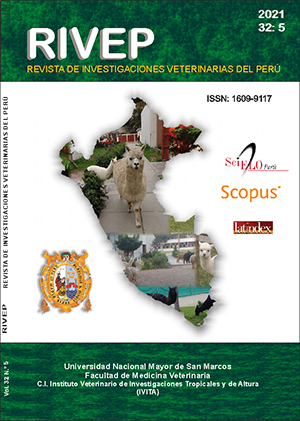Post mortem diagnosis of Fasciola hepatica in cattle slaughtered at the Sogamoso, Boyacá processing plant (Boyacá, Colombia)
DOI:
https://doi.org/10.15381/rivep.v32i5.21341Keywords:
Fasciola hepatica, cattle, prevalence, ELISAAbstract
The aim of this study was to determine the prevalence of hepatic dystomatosis in cattle slaughtered in the Sogamoso slaughterhouse (Boyacá, Colombia), and to define the most effective diagnostic technique to establish the presence of the parasite. A sample size of 343 individuals was established considering the monthly slaughter rate of the plant. Stool, blood and bile samples were taken, and adult parasites were collected from the bile duct. The modified Ritchie technique was used in the coproparasitological examination, the bile content was analyzed by sedimentation and a standardized in-house ELISA was implemented for serological diagnosis from adult Fasciola hepatica parasites. The results showed that 29.7% (102/343) of the individuals sampled were positive for the presence of F. hepatica in at least one of the techniques used. The post mortem evaluation presented the highest value (19.8%; 68/343), followed by the in-house ELISA (13.7%; 47/343), detection of eggs in bile (117%; 40/343) and the coprological technique (7.3%; 25/343).
Downloads
Downloads
Published
Issue
Section
License
Copyright (c) 2021 Melissa Camila Ortiz-Pineda, Omar Alexander Archila-Barrera, Diana María Bulla-Castañeda, Adriana María Díaz-Anaya, Julio Cesar Giraldo Forero, Diego José Garcia-Corredor, Martín Orlando Pulido-Medellín

This work is licensed under a Creative Commons Attribution 4.0 International License.
AUTHORS RETAIN THEIR RIGHTS:
a. Authors retain their trade mark rights and patent, and also on any process or procedure described in the article.
b. Authors retain their right to share, copy, distribute, perform and publicly communicate their article (eg, to place their article in an institutional repository or publish it in a book), with an acknowledgment of its initial publication in the Revista de Investigaciones Veterinarias del Perú (RIVEP).
c. Authors retain theirs right to make a subsequent publication of their work, to use the article or any part thereof (eg a compilation of his papers, lecture notes, thesis, or a book), always indicating the source of publication (the originator of the work, journal, volume, number and date).



